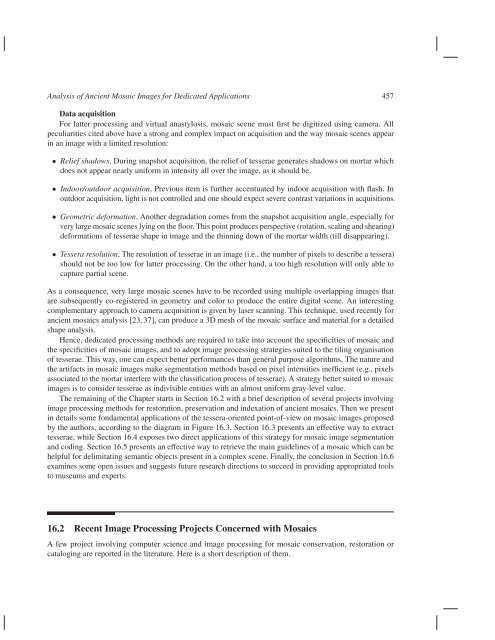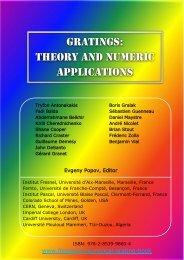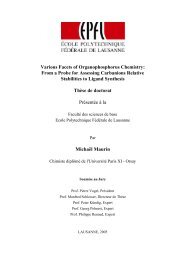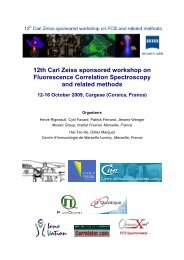Analysis of Ancient Mosaic Images for Dedicated ... - Institut Fresnel
Analysis of Ancient Mosaic Images for Dedicated ... - Institut Fresnel
Analysis of Ancient Mosaic Images for Dedicated ... - Institut Fresnel
You also want an ePaper? Increase the reach of your titles
YUMPU automatically turns print PDFs into web optimized ePapers that Google loves.
<strong>Analysis</strong> <strong>of</strong> <strong>Ancient</strong> <strong>Mosaic</strong> <strong>Images</strong> <strong>for</strong> <strong>Dedicated</strong> Applications 457<br />
Data acquisition<br />
For latter processing and virtual anastylosis, mosaic scene must first be digitized using camera. All<br />
peculiarities cited above have a strong and complex impact on acquisition and the way mosaic scenes appear<br />
in an image with a limited resolution:<br />
• Relief shadows, During snapshot acquisition, the relief <strong>of</strong> tesserae generates shadows on mortar which<br />
does not appear nearly uni<strong>for</strong>m in intensity all over the image, as it should be.<br />
• Indoor/outdoor acquisition, Previous item is further accentuated by indoor acquisition with flash. In<br />
outdoor acquisition, light is not controlled and one should expect severe contrast variations in acquisitions.<br />
• Geometric de<strong>for</strong>mation, Another degradation comes from the snapshot acquisition angle, especially <strong>for</strong><br />
very large mosaic scenes lying on the floor. This point produces perspective (rotation, scaling and shearing)<br />
de<strong>for</strong>mations <strong>of</strong> tesserae shape in image and the thinning down <strong>of</strong> the mortar width (till disappearing).<br />
• Tessera resolution, The resolution <strong>of</strong> tesserae in an image (i.e., the number <strong>of</strong> pixels to describe a tessera)<br />
should not be too low <strong>for</strong> latter processing. On the other hand, a too high resolution will only able to<br />
capture partial scene.<br />
As a consequence, very large mosaic scenes have to be recorded using multiple overlapping images that<br />
are subsequently co-registered in geometry and color to produce the entire digital scene. An interesting<br />
complementary approach to camera acquisition is given by laser scanning. This technique, used recently <strong>for</strong><br />
ancient mosaics analysis [23, 37], can produce a 3D mesh <strong>of</strong> the mosaic surface and material <strong>for</strong> a detailed<br />
shape analysis.<br />
Hence, dedicated processing methods are required to take into account the specificities <strong>of</strong> mosaic and<br />
the specificities <strong>of</strong> mosaic images, and to adopt image processing strategies suited to the tiling organisation<br />
<strong>of</strong> tesserae. This way, one can expect better per<strong>for</strong>mances than general purpose algorithms. The nature and<br />
the artifacts in mosaic images make segmentation methods based on pixel intensities inefficient (e.g., pixels<br />
associated to the mortar interfere with the classification process <strong>of</strong> tesserae). A strategy better suited to mosaic<br />
images is to consider tesserae as indivisible entities with an almost uni<strong>for</strong>m gray-level value.<br />
The remaining <strong>of</strong> the Chapter starts in Section 16.2 with a brief description <strong>of</strong> several projects involving<br />
image processing methods <strong>for</strong> restoration, preservation and indexation <strong>of</strong> ancient mosaics. Then we present<br />
in details some fondamental applications <strong>of</strong> the tessera-oriented point-<strong>of</strong>-view on mosaic images proposed<br />
by the authors, according to the diagram in Figure 16.3. Section 16.3 presents an effective way to extract<br />
tesserae, while Section 16.4 exposes two direct applications <strong>of</strong> this strategy <strong>for</strong> mosaic image segmentation<br />
and coding. Section 16.5 presents an effective way to retrieve the main guidelines <strong>of</strong> a mosaic which can be<br />
helpful <strong>for</strong> delimitating semantic objects present in a complex scene. Finally, the conclusion in Section 16.6<br />
examines some open issues and suggests future research directions to succeed in providing appropriated tools<br />
to museums and experts.<br />
16.2 Recent Image Processing Projects Concerned with <strong>Mosaic</strong>s<br />
A few project involving computer science and image processing <strong>for</strong> mosaic conservation, restoration or<br />
cataloging are reported in the literature. Here is a short description <strong>of</strong> them.













